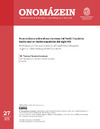Please use this identifier to cite or link to this item:
https://accedacris.ulpgc.es/jspui/handle/10553/43287
| DC Field | Value | Language |
|---|---|---|
| dc.contributor.author | Cáceres Lorenzo, Teresa | en_US |
| dc.contributor.other | Caceres Lorenzo, Maria Teresa | - |
| dc.date.accessioned | 2018-11-21T14:00:47Z | - |
| dc.date.available | 2018-11-21T14:00:47Z | - |
| dc.date.issued | 2013 | en_US |
| dc.identifier.issn | 0717-1285 | en_US |
| dc.identifier.uri | https://accedacris.ulpgc.es/handle/10553/43287 | - |
| dc.description.abstract | En textos españoles del siglo XVI se docu-mentan glosas explicativas que acompañan a voces del fondo hispánico tradicional. Dichas apostillas indican que los indios o los que for-man parte de las primeras ciudades americanas emplean léxico español que los autores desco-nocen o consideran extrañas a su vocabulario patrimonial. Los autores principalmente impli-cados en estos casos son funcionarios y algunos cronistas con una actitud purista ante el vocabu-lario. El análisis de los ejemplos no investigados hasta el momento en este contexto, permite ase-verar que estos son de procedencia árabe o por-tuguesa, o son producto de cambios semánticos, y derivados con significados muy alejados de la voz originaria. | en_US |
| dc.description.abstract | Spanish texts from the 16th century inclu-ded some explanatory notes accompanying words of traditional Hispanic origin. These an-notations indicate that indigenous people or Spaniards living in the first American cities em-ployed a lexicon unfamiliar or unknown to the annotators' inherited traditional Spanish voca-bulary. The annotators mainly involved in these cases were civil servants as well as some jour-nalists with a puristic attitude towards vocabu-lary. Analyses of under researched examples of the lexicon in question reveal that these words are of Arabic or Portuguese origin, which are the product of semantic changes, or derivatives with meanings very distant from those of the original phrases. This transformation indicates a first-le-vel separation between the lexicon employed in America and the one that was used in Peninsular Spain. | en_US |
| dc.language | spa | en_US |
| dc.publisher | 0717-1285 | |
| dc.relation.ispartof | Onomazein | en_US |
| dc.source | Onomazein [ISSN 0717-1285], v. 27, p. 135-143 | en_US |
| dc.subject | 5703 Geografía lingüística | en_US |
| dc.subject | 570201 Lingüística histórica | en_US |
| dc.subject.other | Fondo léxico hispánico tradicional | en_US |
| dc.subject.other | Siglo XVI | en_US |
| dc.subject.other | Traditional Hispanic words | en_US |
| dc.subject.other | 16th century | en_US |
| dc.title | Nuevos datos sobre el uso de voces del fondo hispánico tradicional en textos españoles del siglo XVI | en_US |
| dc.title.alternative | New data on the use of words of traditional Hispanic origin in 16th-century American texts | en_US |
| dc.type | info:eu-repo/semantics/Article | en_US |
| dc.type | Article | en_US |
| dc.identifier.scopus | 84883229310 | - |
| dc.identifier.isi | 000323282300009 | - |
| dcterms.isPartOf | Onomazein | |
| dcterms.source | Onomazein[ISSN 0717-1285] (27), p. 135-143 | |
| dc.contributor.authorscopusid | 18036395700 | - |
| dc.description.lastpage | 143 | en_US |
| dc.description.firstpage | 135 | en_US |
| dc.relation.volume | 27 | en_US |
| dc.investigacion | Artes y Humanidades | en_US |
| dc.type2 | Artículo | en_US |
| dc.identifier.wos | WOS:000323282300009 | - |
| dc.contributor.daisngid | 2797099 | - |
| dc.contributor.daisngid | 12191408 | - |
| dc.description.notas | Spanish texts from the 16th century inclu-ded some explanatory notes accompanying words of traditional Hispanic origin. These an-notations indicate that indigenous people or Spaniards living in the first American cities em-ployed a lexicon unfamiliar or unknown to the annotators' inherited traditional Spanish voca-bulary. The annotators mainly involved in these cases were civil servants as well as some jour-nalists with a puristic attitude towards vocabu-lary. Analyses of under researched examples of the lexicon in question reveal that these words are of Arabic or Portuguese origin, which are the product of semantic changes, or derivatives with meanings very distant from those of the original phrases. This transformation indicates a first-le-vel separation between the lexicon employed in America and the one that was used in Peninsular Spain. | en_US |
| dc.identifier.investigatorRID | E-7840-2010 | - |
| dc.identifier.external | WOS:000323282300009 | - |
| dc.identifier.external | WOS:000323282300009 | - |
| dc.utils.revision | Sí | en_US |
| dc.contributor.wosstandard | WOS:Caceres-Lorenzo, MT | - |
| dc.date.coverdate | Junio 2013 | en_US |
| dc.identifier.ulpgc | Sí | en_US |
| dc.description.sjr | 0,161 | |
| dc.description.jcr | 0,07 | |
| dc.description.sjrq | Q3 | |
| dc.description.jcrq | Q4 | |
| dc.description.ahci | AHCI | |
| dc.description.ssci | SSCI | |
| item.grantfulltext | open | - |
| item.fulltext | Con texto completo | - |
| crisitem.author.dept | GIR IATEXT: División de Estudios de Corpus y Lingüística Aplicada | - |
| crisitem.author.dept | IU de Análisis y Aplicaciones Textuales | - |
| crisitem.author.dept | Departamento de Filología Hispánica, Clásica y de Estudios Árabes y Orientales | - |
| crisitem.author.orcid | 0000-0002-1683-9025 | - |
| crisitem.author.parentorg | IU de Análisis y Aplicaciones Textuales | - |
| crisitem.author.fullName | Cáceres Lorenzo, M. Teresa | - |
| Appears in Collections: | Artículos | |
SCOPUSTM
Citations
2
checked on Jun 8, 2025
Page view(s)
60
checked on May 4, 2024
Download(s)
44
checked on May 4, 2024
Google ScholarTM
Check
Share
Export metadata
Items in accedaCRIS are protected by copyright, with all rights reserved, unless otherwise indicated.
